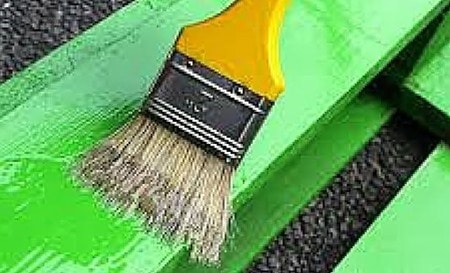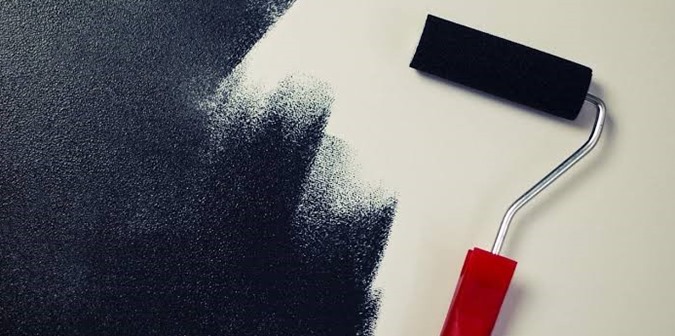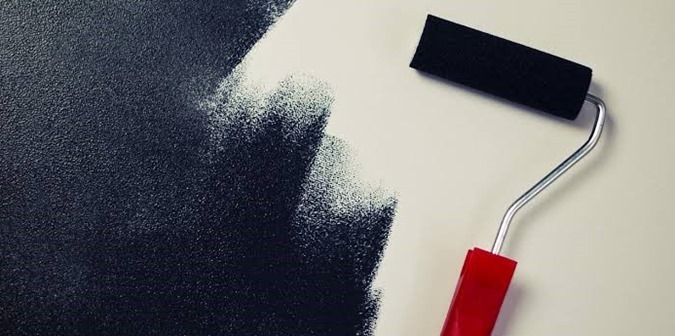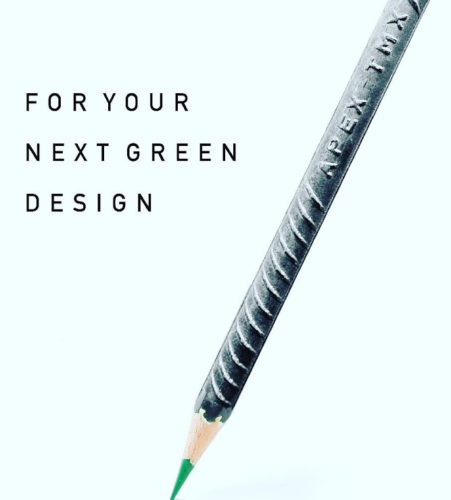Painting on a surface is not the same for all surface types. Some precautions are to be taken before and after painting. Methods and process of painting on different surfaces are discussed.
Methods and Process of Painting on Different Surfaces
- New woodwork
- Repainting Old wood surface
- New iron and steel surfaces
- Repainting of old steel and iron surfaces
- Galvanized iron surface
- Metals
- Plastered surfaces
Painting on New Wood Work
Following are the steps for painting new wooden surfaces:
- Surface preparation
- Knotting
- Priming
- Stopping
- Undercoating
- Finishing
1. Surface Preparation of Wooden Works
The surface should be well cleaned without any dust, spots, greasy matter etc. The nails used in the woodwork should be punched up to 3mm below the surface. The wood in woodwork should be well seasoned and should not contain more than 15% of moisture content. The surface should be dry.
2. Knotting
Knots present in the wood may eject resins from wood. So, knots are killed or covered in this knotting process. Knotting can be done in two ways as follows:
1. In this first method, two coats of solutions are applied to the surface. The first coat consists 15g of red lead, 2 litres of water and 225 grams of glue.
After adding these three, the mixture is heated and applied and left for 10 minutes. After that second coat is applied which consists of red lead ground in boiled linseed oil and thinned with turpentine oil.
2. In this method, a hot lime coat is applied on the surface and left it for 24 hours. After that, the layer is scraped off from the surface.
3. Priming of New Wooden Surface
Priming is nothing but applying a prime coat or first coat on the surface. In this case, the surface is smoothened with abrasive paper and the first coat of paint is applied to fill all the pores in the surface. The ingredients used in this prime coat is the same as subsequent coats but the quantity or composition ratio may vary.
4. Stopping
After filling all the pores of the wooden surface in priming, it’s time to fill up nail holes, dents, cracks, etc. Putty is used as the fill material. When putty is dried, then the whole surface is rubbed with glass paper or pumice stone. This process of rubbing down the wooden surface is called stopping.
5. Under Coating of New Wooden Surface
In general, for good quality works, 4 coats of paints are applied (prime + under coatings + finishing). For inferior quality works 2 to 3 coats can be used. So, undercoatings are nothing but second and third coats of good quality works which provides same look or shade as finishing coat. For better results, enough time should be allowed for each coat.
6. Finishing of New Wooden Surface
Finishing is the last coat applied on the surface which is generally applied on the undercoatings. It should be applied in a smooth, uniform manner. It decides the whole final look of the surface, so, skilled workers are required for better results.

Repainting of Old Wooden Surface
Old woodwork can be repainted but the previous paintwork should be removed. The removal is more important which can be done in many ways as follows:
- Prepare a solution of 1 kg caustic soda in 5 litres of water and apply on the old painted surface. When this solution is applied on the surface, the old paint gets dissolved and removed easily.
- Another method is, prepare a hot solution consisting of soft soap, potash, quicklime in the ratio 1:2:1. This solution is applied on the old surface and washed with hot water.
- 1:1 mixture of washing soda and quicklime is prepared and applied on old paint surface and then washed with water.
After applying any of the three methods described above, the surface is ready for fresh painting. Before that the surface is rubbed with the pumice stone or glass paper and then 2 to 3 coats of paints are applied.

Painting of New Iron and Steel Surfaces
Painting of iron and steel surfaces will resist the rust formation due to weathering. Before painting the surface must be cleaned. If there is any rust or scales, should be wiped off using steel brushes etc. stains on surface can be washed with benzene or lime water.
Before applying a prime coat, the surface should be treated with phosphoric acid to get better adhesive nature. Now prime coat is applied which consists 3kg of red lead in 1 litre of boiled linseed oil. This should be applied using a brush.
After that, two or more undercoats are applied which consist of 3 kg of red lead in 5 litres of boiled linseed oil. After drying up, smooth finishing coat of desired paint is applied.

Repainting of Old Steel and Iron Surfaces
Repainting of steel and iron surfaces is as same as new surfaces but the cleaning of old paint is most important. Oxyacetylene flame is used to burn off the paint surface and then it is scrapped with brushes.
Painting of Galvanized Iron Surface
In general, the Galvanized iron surface does not contain adhesive nature with paint. So, it is difficult to apply paint on it without any special action. That special treatment may be applying different solutions on the surface.
The solutions are 40 grams of copper acetate in one litre of water or 13 grams each of copper chloride, copper nitrate, muriatic acid and ammonium chloride in 1 litre of water. Anyone of these two solutions is mixed in an earthen vessel and applied on the surface. When the surface turns into black, then prime coat is applied after it dries, finishing coat is applied.
Painting of Plastered Surfaces
Painting of newly plastered surfaces is difficult because of moisture content present in the plaster material. The heat of hydration of cement also causes severe problems for paints especially oil-based paints and distempers are liable to alkali attack.
To overcome this, alkali resistant primer is used in prime coat. The plastered surface contains pores in it, and whenever the paint is applied, liquid from the paint is absorbed by these pores which are called suctions. The suction of surface depends upon the type of paint, prime coat composition, etc. Suction should be uniform throughout the surface.

S0, the preparation of surface depends upon the type of paint used on the surface. For different paints, different types of pretreatments are adopted on the surface which is described in below table.
| Type of paint | Preparation of surface |
| Oil paint | A coat of thin primer or prime sealer |
| Emulsion paint | A coat of paint thinned with water |
| Dry distemper | Same distemper thinned with water |
| Size bound distemper | A Coat of clearcole |
| Cement paint and lime wash | Just wet the surface before applying. |



